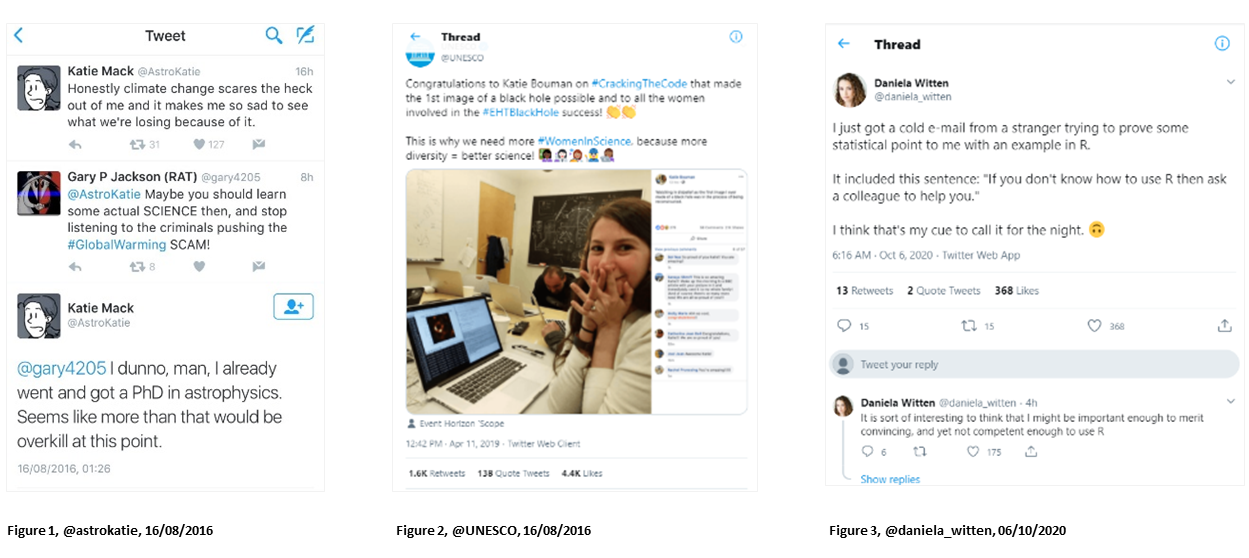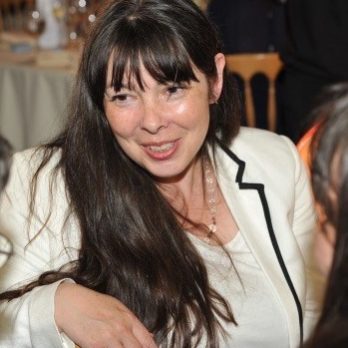The Last Word

Author: Dr Jaine Blayney
Being a woman in an academic meeting can sometimes be somewhat reminiscent of being a four-year-old in a pre-school setting à la Joyce Grenfell’s Nursery School.[1], [2] You sit there quietly with your hair neatly plaited, arms folded correctly, waiting patiently for your turn. Meanwhile, George and Sidney are running around eating buttons and sticking paintbrushes into girls’ ears.
How do we amplify voices over the chaos? Sitting quietly with our hair plaited neatly, arms folded carefully, did not work then and it does not work now. As women, this selective hearing is not just confined to run of the mill meetings at universities. We receive fewer invites to speak at conferences or seminars,[3] and as lecturers, our voices are evaluated differently to those of our male colleagues.[4]
Online, with a wider audience, does our experience differ? How are the confident, competent women of science heard on Twitter? Are our virtual views and contributions welcomed? Well, the good news is, no, we are not avoided. However, the reactions are not always positive.
Exhibit A: Katie Mack (@AstroKatie), a theoretical cosmologist and Assistant Professor at North Carolina State University, whose research includes dark matter and vacuum decay, expressed some concern regarding climate change. Out of nowhere, pops a stranger, in search of an ear, wielding a large paintbrush. Mack’s response is worthy of a Nobel Prize for literature (Figure 1).[5]
So where did this stranger’s confidence come from? Did they pour over multiple research articles for years before contributing their tuppence-worth? Perhaps.
Exhibit B: Katie Bouman (no active twitter account), an MIT postdoctoral researcher who developed algorithms that helped to deliver the first image of a black hole (Figure 2)[6]. The sheer delight on Bouman’s face is infectious, I want to hug her to share the joy. Bouman’s contribution was questioned, claiming that there was an inverse relationship between her level of participation and credit.[7] Andrew Chael, another member of the team, came to Bouman’s defence, rapidly and vociferously[8]. A true colleague; I want to hug him too. Chael is a perfect role model, not a paintbrush in sight. Yes, #notallmen are trolls, women troll other women (and men). However, we are at greater risk of being targets. Try being a prominent woman of colour, a lesbian woman, an older woman or a woman with a disability, online for a day, then get back to me (I have enough arnica to go around).
What is the motivation of these Twitter trolls? Trolling has been associated with what has been collectively described as dark personality traits (narcissism, psychopathy, Machiavellianism and sadism).[9] Gender-trolling, the targeting of women online, is proof that abusive behaviour is capable of mutating, like a virus, into new settings.[10] There are different types of trolling: sealioning (a random stranger butts into your conversation), dogpiling (villagers with pitchforks) and gaslighting (you doubt yourself and your own sanity).[11]

Exhibit C: Daniela Witten is Professor of Statistics and Biostatistics and a Dorothy Gilford Endowed Chairat the University of Washington. Witten is a co-author on a key statistical textbook in R.[12] Witten recently reported that a random stranger (sex unknown) emailed her with a statistical example (Figure 3).[13] The email included “If you don’t know how to use R then ask a colleague to help you”. This was such peak sealioning, that you could almost smell the fish.
Harvard’s Women in Computer Science Advocacy Council surveyed 900 undergraduate students with respect to their attitudes towards computing.[14] One key finding was that men with less than one year of programming experience were as confident as women with eight years of experience. Let me re-interpret that for you, arrogance and ignorance are a heady mix.[15] (yes, that’s a Wikipedia reference).
I wonder what my heroines, Dorothy Parker and Jane Austen, would have made of Twitter. Parker would have been suited perfectly to the immediate, quickfire nature of the platform, not only having the last word, but the last laugh. Whereas, I imagine Austen as a multi-threader (1/n), with seemingly polite replies containing rebukes which would only hit home a week later.
As for myself, I am on Twitter, but under a pseudonym. I rarely tweet; I am there mainly for the LOLZ. I seldom use it for scientific purposes. Is Twitter the right home for science communication? Possibly, though not for me, yet. I need to conserve my energy; I have some paintbrushes to remove from my ear courtesy of my last online meeting.
[1] Make ‘Em Laugh, nd, accessed 30 September 2020. Available at: https://www.monologues.co.uk/First_Ladies/Going_Home_Time.htm
[2] Make ‘Em Laugh, nd, accessed 30 September 2020. Available at: https://www.monologues.co.uk/First_Ladies/Flowers.htm
[3] Klein, Robyn S et al. “Speaking out about gender imbalance in invited speakers improves diversity.” Nature immunology, 18,5 (2017): 475-478. doi:10.1038/ni.3707
[4] Boring, A., Ottoboni, K., & Stark, P.B. Student evaluations of teaching (mostly) do not measure teaching effectiveness, Science OpenResearch, 2016, doi: 10.14293/S2199-1006.1.SOR-EDU.AETBZC.v1
[5] Mack, K. (2016) 16 August. Available at http://www.twitter.com/astrokatie (Accessed: 30 September 2020)
[6] UNESCO (2019) 11 April. Available at https://twitter.com/unesco/ (Accessed: 30 September 2020).
[7] Filipovic, J (2019). The misogynist trolls attacking Katie Bouman are the tip of the trashpile, The Guardian, London, 17 April. Available at: https://www.theguardian.com/commentisfree/2019/apr/17/katie-bouman-black-hole-image-online-trolls (Accessed: 30 September 2020)
[8] Griffin, A (2019). Katie Bouman: Black Hole Colleagues Dismiss Attacks Over Hero Scientists's Role in Creating Famous Image. available at: https://www.independent.co.uk/life-style/gadgets-and-tech/news/katie-bouman-black-hole-image-first-telescope-a8866536.html (Accessed: 30 September 2020).
[9] Panek E. T., Nardis Y., Konrath S. (2013). Mirror or megaphone?: How relationships between narcissism and social networking site use differ on Facebook and Twitter. Computers in Human Behavior, 29(5), 2004–2012. doi:10.1016/j.chb.2013.04.012
[10] Mantilla, K (2013). Gendertrolling: Misogyny Adapts to New Media, Feminist Studies, 39, 2, 563-570
[11] Sarkeesian, A (2015). Anita Sarkeesian's Guide to Internetting While Female. Marie Claire, March 2015. Available at: https://www.marieclaire.com/culture/news/a13403/online-harassment-terms-fight-back/ (Accessed: 30 September 2020).
[12] James, GM, Hastie, T, Witten, D, Tibshirani, R (2013). An Introduction to Statistical Learning, Springer-Verlag, New York
[13] Witten, D. (2020) 6 October. Available at http://www.twitter.com/daniela_witten (Accessed: 6 October 2020).
[14] Women in Computer Science Advocacy Council, 2015 accessed 30 September 2020. Gender in Tech at Harvard. Available at: http://advocacy.harvardwics.com./report/
[15] Dunning-Kruger Effect, 5 October, 2020. Accessed 6 October 2020. Available at: https://en.wikipedia.org/wiki/Dunning%E2%80%93Kruger_effect
Dr Jaine Blayney studied Maths at Somerville College, Oxford, Computing and Info Systems then Bioinformatics at Ulster University. She has spent 15 years working with charities, in advice, training and counselling.
Dr Blayney currently works at Queen's University Belfast as a Lecturer in Translational Bioinformatics and is Course Director for MSc Bioinformatics/Computational Genomics.
Dr Blayney uses mathematics, statistics and computing in biomedical research to uncover new biological insights from patient data. She is particularly interested in separation of patients into different subgroups, based on the complex biological patterns found in tissue or blood samples, which can help speed up treatment response and patient recovery. Just as there is not a one-treatment fits all, different patient data may require the application of different statistical modelling or machine learning techniques.
2019 awards:
- @WITAwardsDublin (All-Ireland Women in Tech, Data Scientist)
- @WATC_WeAreTech (All-UK WeAreTEch TechWomen100)
- British Computer Society NI IT Professional of the Year
